HIGHLIGHTS: March 10, 2023
• January export numbers
• USDEC meets with McKalip
• USDEC updates Global Cheese Database
• Codex Nutrition Committee developments
• Honoring USDEC overseas offices on International Women’s Day
• U.S. CDE permeate workshop targets bakery/confectionery manufacturers
• Photos and video from Gulfood
• Food Ingredients China next week
• Membership Meeting: sustainability, dairy alternatives
• Market Summary: Ample supply, tepid demand
• EU farmgate milk prices tumbling
• Ireland, Denmark push climate schemes
• Company news: FrieslandCampina, McDonald's
Featured
U.S. exports start big in 2023
U.S. dairy export started 2023 like they ended 2022: on a high note. Year-over-year total volume jumped 16% in milk solids equivalent terms (+25,026 MT) with big gains in NFDM/SMP, lactose, whey and cheese.
Export value rose 21% to $710.9 million. Both value and volume were January records—an outcome that has become the norm over the last eight months.
NFDM, the only major product category to contract in 2022, was the star at the start of 2023. U.S. NFDM/SMP exports jumped 15%, driven by a record setting month to Mexico. Tight Mexican milk supply and favorable U.S. pricing sent U.S. NFDM/SMP shipments to Mexico soaring 75% to 36,520 MT (+15,625 MT).
U.S. cheese exports continue to shine, rising 16% to 34,015 MT (+4,582 MT). The last month year-over-year cheese exports declined was June 2021. We continued to see broad-based geographic growth in January, with shipments up to Mexico +21% (+1,578 MT), Central America +51% (+1,262 MT), Middle East/North Africa +55% (+1,005 MT), and Japan +35% (+968 MT).
Total whey exports increased 12% in January (+4,920 MT), with China driving lower protein varieties and a variety of buyers providing a lift to WPC80+. U.S. lactose exports grew 30% (+8,794 MT) led by a 47% increase in shipments (+3,217 MT) to Southeast Asia.
For more information, read the U.S. Dairy Export Blog post, “U.S. dairy exports start strong in 2023,” or visit the USDEC Data Hub and experiment with the interactive charts under the U.S. Exports tab.
USDEC meets with Doug McKalip on U.S. dairy trade priorities
USDEC Executive Vice President, Policy Development and Strategy Jaime Castaneda and Senior Vice President, Trade Policy Shawna Morris met yesterday with Doug McKalip, the USTR’s Chief Agricultural Negotiator. The meeting was the latest in a series of discussions between USDEC and key U.S. government trade officials focusing on U.S. dairy trade priorities. USDEC President and CEO Krysta Harden, Castaneda and Morris met twice with USDA Under Secretary for Trade and Foreign Agricultural Affairs Alexis Taylor in February (see Global Dairy eBrief, 2/24/23).
The meeting reinforced U.S. dairy priorities USDEC communicated in a January letter to McKalip and Taylor. Those issues include expanding markets through the negotiation of new free trade agreements (prioritizing major dairy-importing countries), establishing explicit protections for common food names to combat the misuse of geographical indications, advocating for science-based standards and trade rules in multilateral organizations and more.
Speaking at USDEC membership meeting
McKalip and Taylor will offer their outlooks for U.S. agricultural trade at a panel at the upcoming USDEC Spring Membership Meeting, March 27-29, at Washington, D.C.’s Willard Intercontinental Hotel. Morris will moderate the session, which takes place directly after lunch on March 28.
Download the preliminary agenda to see the full slate of invited and confirmed speakers for the meeting. Then register to attend by clicking here.
Global Cheese Database updated with new data
USDEC’s proprietary, members-only global cheese database has been updated with the latest data on 39 cheese varietals in 48 countries. Watch this five-minute video to see an overview of changes to the cheese dashboard as well as tips for maximizing use.
With estimates now going through 2021 and forecasts through 2027, the dashboard provides valuable insights into global cheese production, consumption and trade flows. The database enables greater transparency and foresight than traditional HS-code-based trade data and fills the gaps where trade statistics are non-existent to help you size export markets and identify growth opportunities.
Access the database here. For additional insight into key changes and logic, view the commentary document here.
Codex Nutrition Committee meeting yields largely positive results
Nick Gardner, USDEC senior vice president, Sustainability and Multilateral Affairs, was in Germany this week for a meeting of the Codex Committee on Nutrition and Foods for Special Dietary Uses (CCNFSDU). The CCNFSDU delivered mostly positive results for U.S. dairy along with one setback. Two proposals with the potential to undermine dairy failed to generate a consensus to start new work: a proposal on developing guidelines for the nutritional composition of foods and beverages made from plant-based and other protein sources; and a proposal for a nutrient reference value for trans-fat. Neither will move forward this year but could reappear as proposals at next year’s meeting.
The setback came when the Committee—over the objection of 10 countries, including the U.S.—forwarded for adoption the follow-up formula standard preamble with language referencing the World Health Organization (WHO) Code of Marketing of Breast-Milk Substitutes. USDEC identified this issue, given concerns that the WHO reference could set a precedent for restrictions on the marketing of dairy products for young children. USDEC will continue to monitor and engage as warranted as this standard moves forward for adoption by the Codex Alimentarius Commission in November.
Honoring the women in USDEC’s overseas offices on International Women’s Day
USDEC celebrates women who lead and work in our 10 international offices around the world on International Women’s Day—and year-round. The organization is proud to collaborate with these skilled, dedicated professionals who are helping to blaze the trail for U.S. dairy around the globe. While many members have interacted with some of USDEC’s overseas office representatives, the number of women in our offices might surprise you. Here are their names.
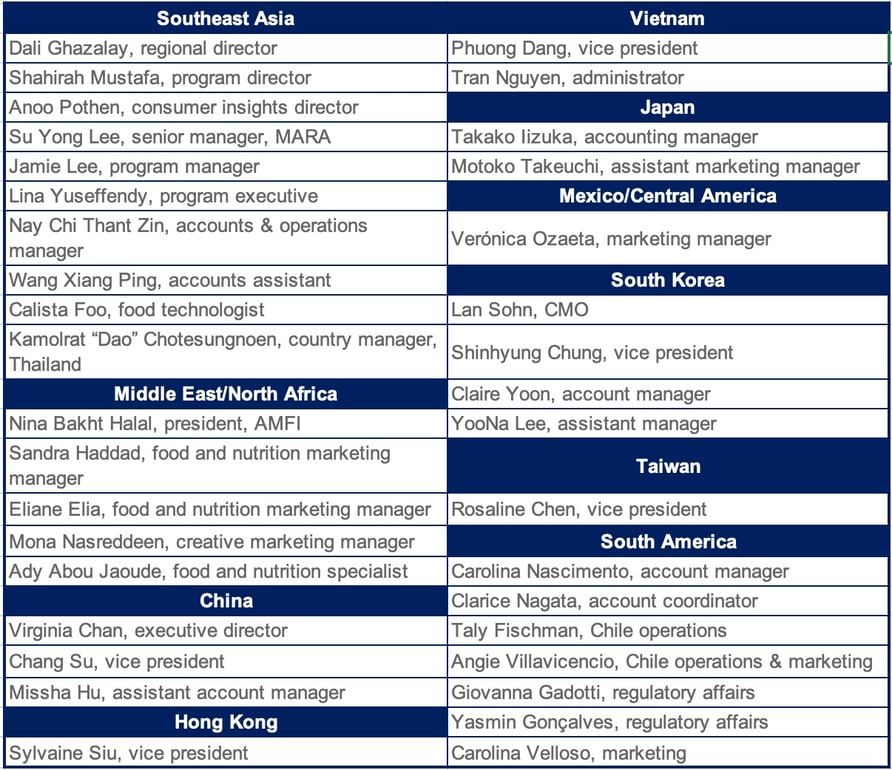
Events
Bakery innovation workshop kicks off new year of dairy ingredients events at the U.S. CDE
Twenty-four food scientists and R&D staff from companies in Singapore, Indonesia, Thailand and the Philippines attended a two-day workshop at the U.S. Center for Dairy Excellence (U.S. CDE) in Singapore this week. The event, “Bakery Innovation: Harnessing the Power of U.S. Dairy Ingredients,” was the first in a series of workshops slated for this year. USDEC will repeat the workshop for attendees from Singapore and Malaysia on April 12-13, and two additional workshops focusing on health and wellness are slated for July 3-4 and July 5-6.
On Day 1 at this week’s event, Martin Teo, USDEC Southeast Asia’s technical director, food applications, led participants through a series of classroom sessions. Teo explained permeate’s benefits in bakery and confectionery applications, conducted taste and sensory tests of products made with permeate and moderated a product innovation and brainstorming session. On Day 2, attendees went to Singapore Polytechnic’s Food Innovation and Resource Center (FIRC) Mix and Bake Lab, where they used their first day of learnings to create their own bakery products using permeate.
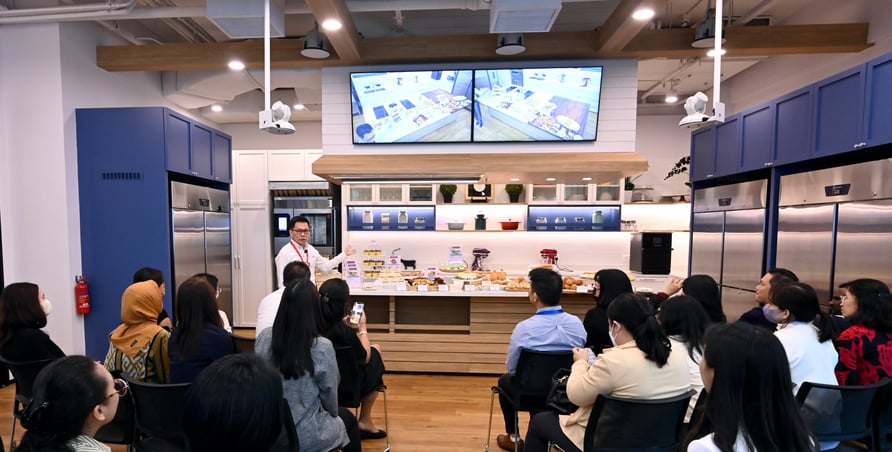
Martin Teo, USDEC Southeast Asia’s technical director, food applications, discusses how U.S. dairy permeate can be used to create innovative bakery items that can be customized to local tastes.
In addition to the training, seven USDEC members gave presentations (live or virtual) on their companies, products and services. In addition, Donna Berry, food scientist, editor and consultant with Dairy & Food Communications Inc., gave a virtual presentation on global trends and new product launches.
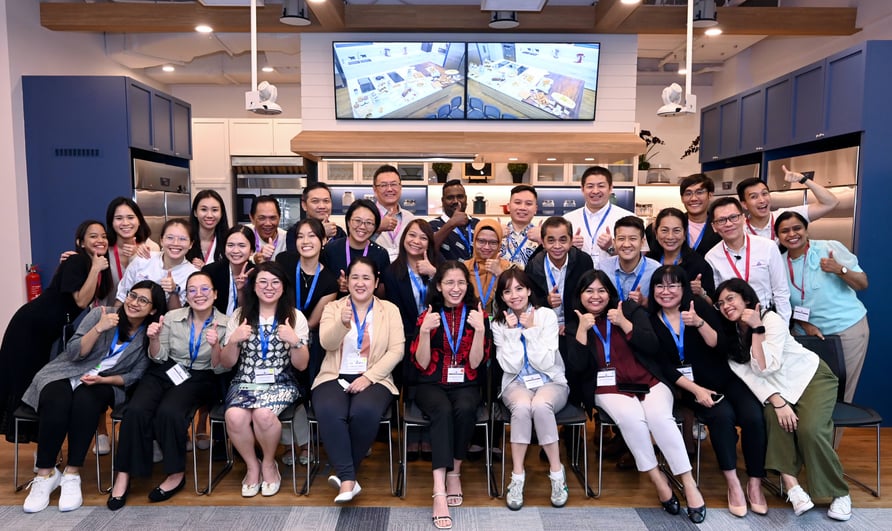
U.S. CDE bakery workshop attendees and USDEC Southeast Asia office staff give a thumbs up to the two-day permeate course. Teo (second row, second from right) will also be at the USDEC Spring Membership Meeting March 27-29 in Washington, D.C.
Images and video from Gulfood 2023
Gulfood, billed as the “world’s largest food exhibition,” was back to pre-COVID ambiance and attendance this year. Waves of showgoers kept the USDEC booth busy throughout the exhibition.
Fourteen companies exhibited alongside USDEC in the U.S. Dairy Pavilion while three additional members held meetings in the USDEC lounge. All reported high interest in U.S. dairy from visitors and expressed a desire to return to the show in 2024. One member mentioned that they conducted more business in one day than they normally do in five days at the show.
The USDEC booth sported a series of new features to entice food and beverage attendees, including a new “USA Cheese Cave,” a “Dairy Ingredients Innovation” showcase and a demo kitchen. Here are a few photos and a video from the show floor. Please note: These images were taken prior to show hours, so they do not illustrate the throngs of buyers that filled the Gulfood floor when the doors open.

Left to right: Merle McNeil, senior vice president, Global Retail Programs; Nina Bakht Halal, head of USDEC’s Middle East/North Africa (MENA) office; Daniel Whitley, administrator of USDA’s Foreign Agricultural Service; and Angélique Hollister, senior vice president, Global Cheese Marketing, show off USDEC’s new USA Cheese Cave.
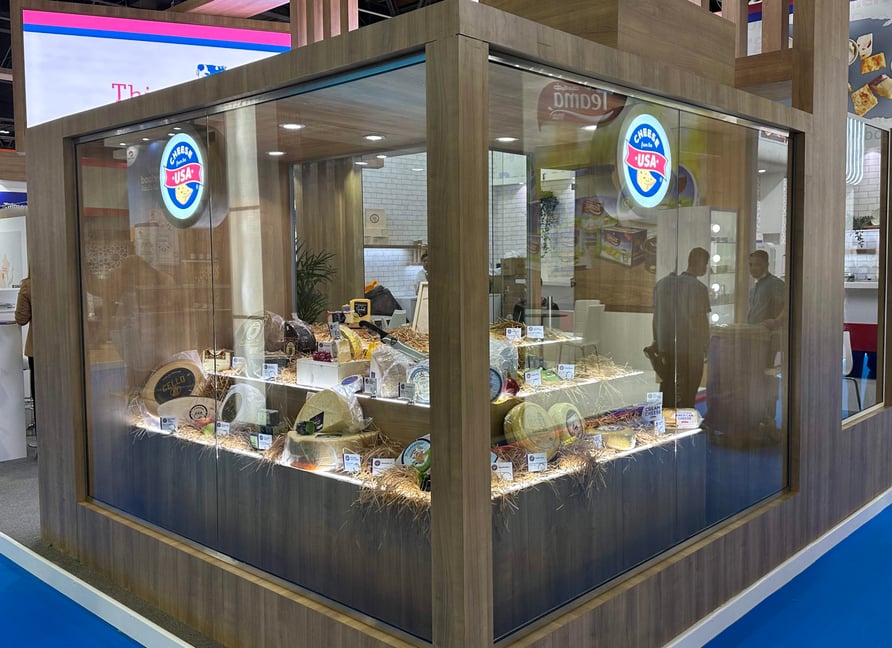
The new USA Cheese Cave’s purpose was to raise the image of U.S. cheese by highlighting the wide variety and high quality of products, including those of exhibiting members.
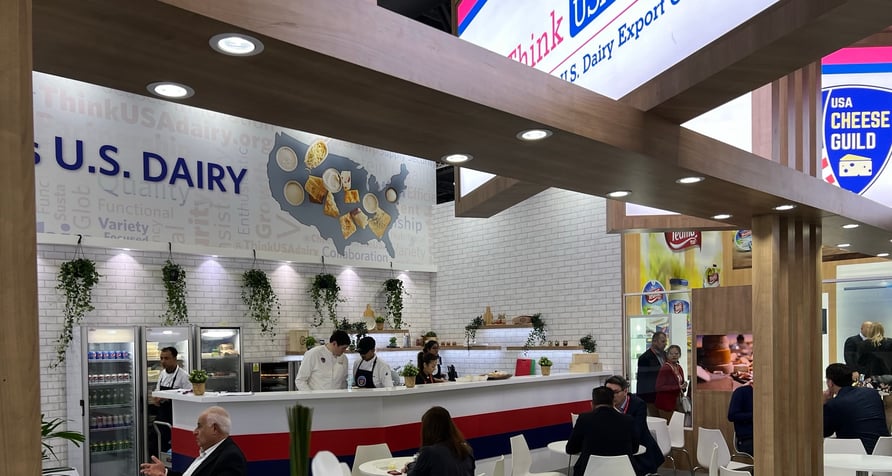
The USDEC demo kitchen where Chef Antonio El Khoury, MENA director of culinary programs, and four graduates of the USA Cheese Specialist Certification Program prepped dishes highlighting USDEC members’ cheeses.

Click here or on the image above for a one-minute video showing a 360-degree view of the USDEC member island at Gulfood.
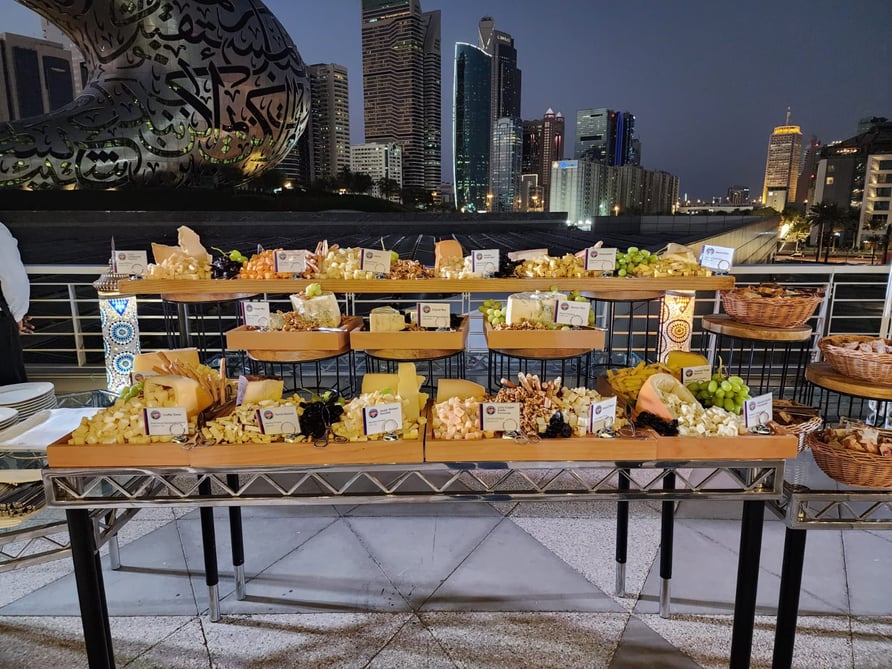
The U.S. cheese table at the FAS reception at the Jumeirah Emirates Tower.
Stop by USDEC’s Food Ingredients China booth next week
USDEC invites members and customers attending next week’s Food Ingredients China (FIC) show, March 15-17 in Shanghai, to stop by booth 41M20 (Hall 4.1) in the USA Pavilion to get a taste of USDEC dairy ingredient marketing efforts in China.
The booth will promote the ongoing partnership between USDEC and China’s Jiangnan University (JU), showcasing joint product innovation work and sampling some of the prototypes developed locally with U.S. permeate and protein ingredients. Visitors stopping by the booth will have an opportunity to meet with two of JU’s Dairy Innovation Center application scientists—Dr. Lina Zhang and Eng. Ruonan Liu—as well as Ms. Chang Su and Mr. Yor Hang Lim from USDEC China. (USDEC will also pass out a flyer with booth information on members exhibiting at FIC.)
By participating in the event, USDEC aims to introduce new potential users to U.S. ingredients and share how to leverage USDEC services and the technical resources developed over the years with the team at JU.
Membership Meeting: Don’t miss the Day 2 sessions on sustainability, dairy alternatives
This year’s USDEC Spring Membership Meeting features an additional half-day of general session meetings focusing on two of the most significant issues affecting dairy today: sustainability and dairy alternatives.
Tom Halverson, president and CEO, CoBank, will lead off the morning of March 29 with a presentation titled, “Climate, Capital and Capacity: How Sustainability Will Impact Industry Investment.”
USDEC’s William Loux, vice president, Global Economic Affairs, will then sit down with James Caffyn, Partner, Lever VC, a venture capital firm focused on finding investments in the alternative proteins sector. The two will discuss, “Dairy Alternatives in the International Market.”
Scenic view at rooftop reception
The full meeting runs March 27-29 at the Willard Intercontinental Hotel in Washington, D.C. A welcome reception takes place on March 27 at the Hotel Washington rooftop terrace on March 27. The rooftop is famous for its views of the White House and Washington Monument.
Download the preliminary agenda to see the full slate of invited and confirmed speakers. Register to attend the meeting by clicking here.
Market Summary
Ample milk supply expectations and tepid demand keep GDT flat
This week’s Global Dairy Trade (GDT) Price Index fell 0.7%, the eighth decline in the last 11 auctions dating back to Oct. 2022. With signs pointing to a healthy Northern Hemisphere peak approaching and global demand still looking slightly sluggish, buyers at the March 7 auction showed no appetite for bidding prices up.
The biggest decline came from cheddar, which plummeted 10.2% (-US$577/MT) to US$4,509MT. Middle East buyers, consistent cheddar purchasers at recent auctions, were largely sidelined, lowering demand and prices. Prices fell for all four contracts, with contract 3 and 4 declining by more than 11.6% and 13.6%, respectively.
SMP prices fell 1.1% to US$2,739MT, will declines across contracts 1-5. The GDT SMP price has slid for three straight auctions and is down 60% from its April 2022 peak.
Despite the lackluster results, there is no clear consensus of market direction. Markets appear rather stable for now, and outside of GDT, reports say that even if global supply is a bit up, demand is holding. The one thing that is unanimous is uncertainty driven by everything from the Ukraine war to the Chinese economy to inflation and economic policy.
European farmgate milk prices eroding
European farmgate milk prices are still well above historical levels but are falling quickly. The weighted average farmgate milk price dropped a combined 6% in January and February, and the trend is continuing (and appears to be accelerating) in March. The losses follow significant dairy commodity price declines in the fourth quarter of 2022 and into the start of the New Year.
Ireland reveals timeline for herd reduction plan; Denmark moots farm emissions tax
Charlie McConalogue, Ireland's Minister for Agriculture, Food and the Marine, said that he plans to announce the details of the country's voluntary herd reduction scheme this year, with a potential roll-out of the plan in 2024. The scheme is part of the country's effort to address climate change and reduce greenhouse gas emissions.
Farm groups have expressed frustration with the lack of detail for the plan. A report prepared for the agriculture department last fall estimated that farmers could lose between €1,770-€2,910 in income (about US$1,870-US$3,074) for every dairy cow they dropped from their herds, suggesting any compensation calculation would at least need to cover those costs.
Denmark suggests farm emissions tax
Meanwhile, an independent advisor to the Danish government recommended an emissions tax on farming as part that country's climate plan. The tax would incentivize dairy and beef farmers to switch to crops and pork production, which emit less greenhouse gases than cattle, the group said.
Nothing is official, but the Danish government said in December that a tax on farming was crucial to achieving its emissions targets. (Agriland, 3/2/23; Irish Independent, 3/2/23; Reuters, 2/21/23)
Company News
Company news briefs
FrieslandCampina Engro Pakistan signed a partnership with Dubai-based trading company Engro Eximp FZE. The deal aims to expand FrieslandCampina Engro dairy exports to the UAE and broader Middle East region. … McThai Co., the operator of McDonald’s restaurants in Thailand, is spending 300 million baht (about US$9 million) to open 10-15 new outlets this year, pushing its total number of units to 237-242. (USDEC Southeast Asia office; PKrevenue.com, 2/23/23)
In Case You Missed It...
U.S. Dairy Exporter Blog
Market analysis, research and news subscribe hereUSDEC Twitter feed
Follow us here.